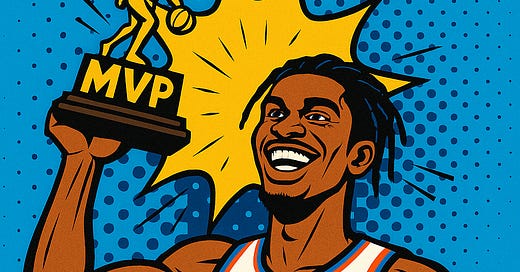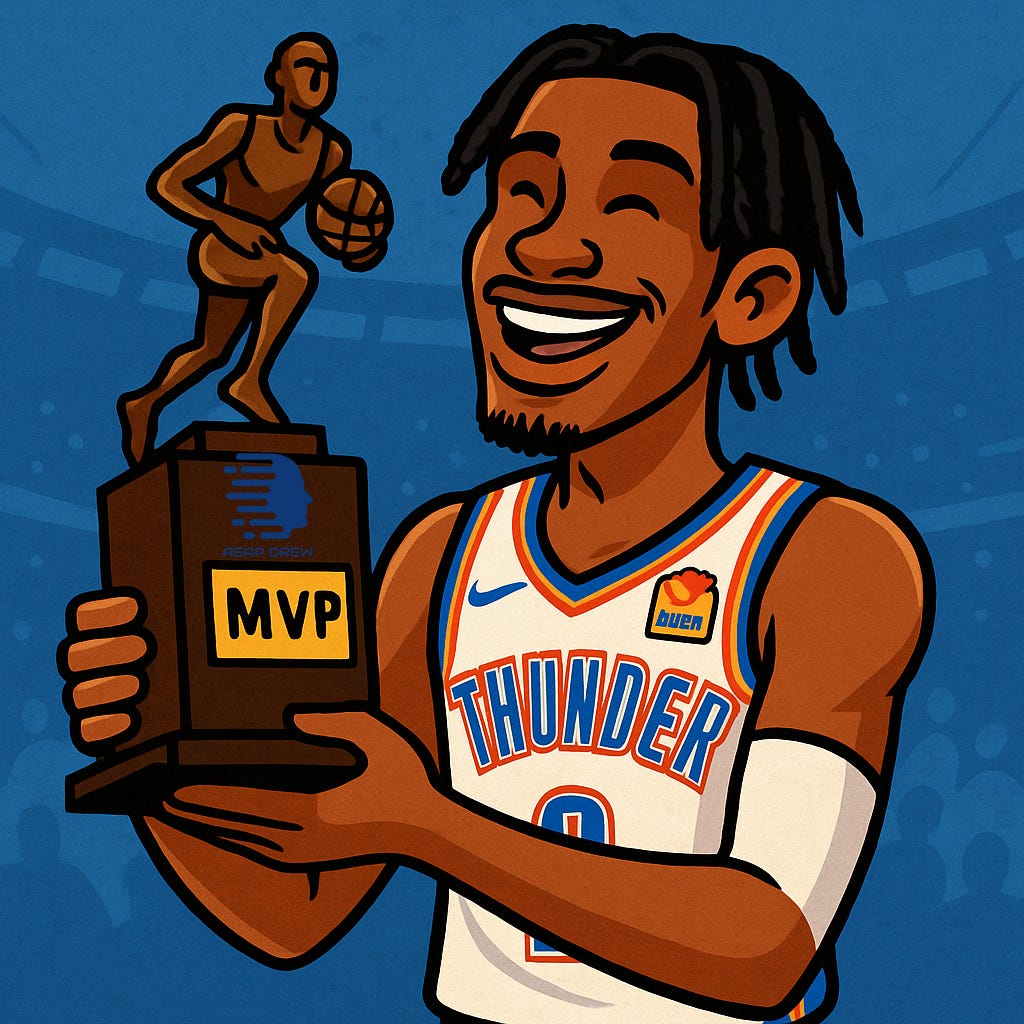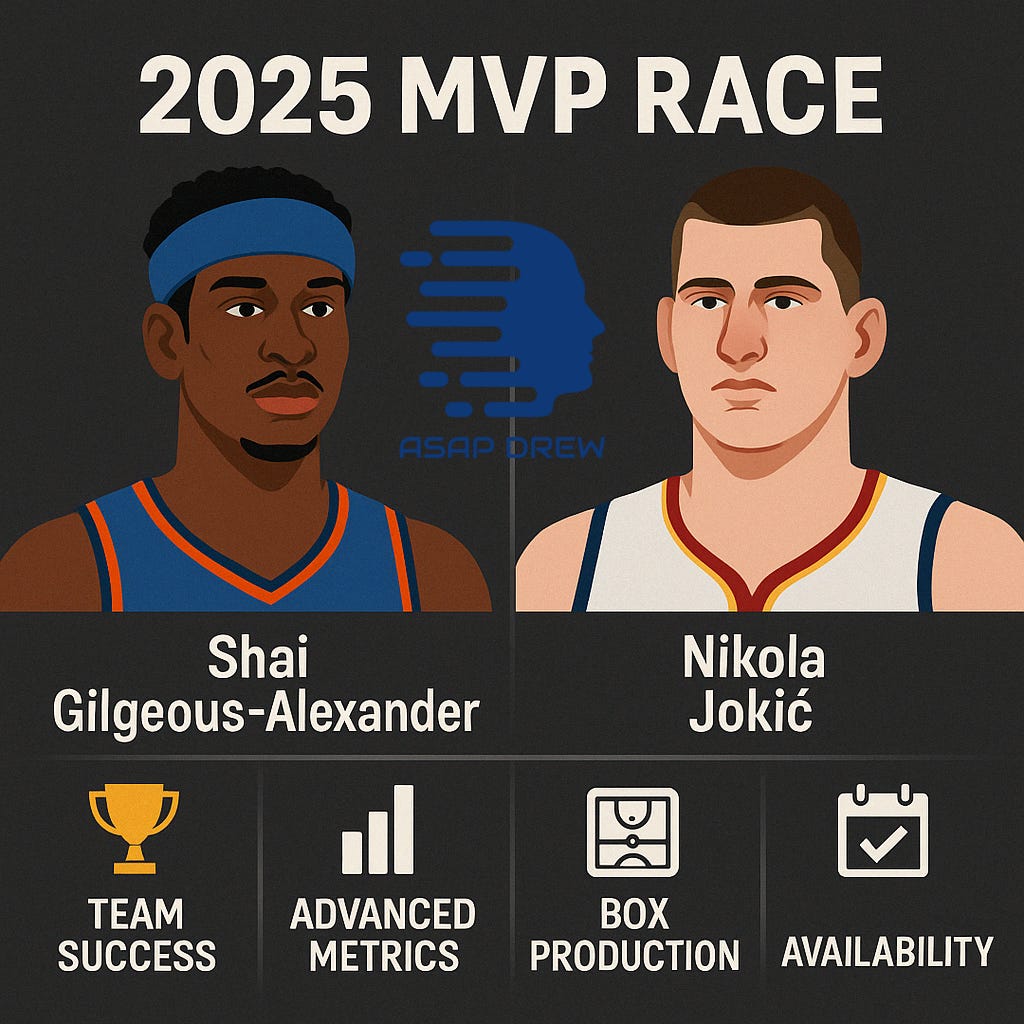2025 NBA MVP Odds & Prediction: Gilgeous-Alexander vs Jokic
2024-25 NBA regular season: Shai likely takes the MVP... Jokic was the NBA's best player in a vacuum.
The 2024‑25 regular season gave NBA watchers a rare dilemma:
Nikola Jokić, Denver’s all‑purpose center, averaged 29.6 points, 12.7 rebounds, and 10.2 assists on 66% true‑shooting (TS) while topping every major lineup‑adjusted impact model (EPM, RAPTOR, LEBRON). Possession for possession, the numbers say no one moved the scoreboard more.
Shai Gilgeous‑Alexander steered a Thunder roster with a 24‑year average age to a 68‑14 record—the league’s best since the 73‑win Warriors of 2016—while winning the scoring title at 32.7 PPG and finishing a whisker behind Jokić in season‑long “wins added.”
Add Giannis Antetokounmpo’s hyper‑efficient 30‑12‑7 campaign and fringe buzz for Luka Dončić and Domantas Sabonis, and you have the densest top tier in recent memory.
Yet the standard signposts—team success, advanced stats, narrative — are pointing in different directions, leaving fans, analysts, and bettors arguing past each other.
I.) Top 3 NBA MVP Candidates: 2024-2025 Season
It is important to emphasize that the NBA MVP award is currently, and has always been, for the regular season.
Many get angry that the MVP winners often don’t win in the playoffs — but there are other awards specifically for post-season success! (NBA Championship trophy/rings & NBA Finals MVP.)
This year the top 2 candidates for regular season MVP were: (1) SGA (OKC) and (2) the Joker (Denver)… with (3) Giannis balling out but not quite breaking into the top 2. (NBA, Regular Season Awards: 2024-2025)
Fringe candidates included guys like: Luka, Tatum, KAT, Sabonis, Jalen Williams, Evan Mobley, LeBron, and Jarrett Allen.
1. Shai Gilgeous‑Alexander (Oklahoma City Thunder)
Historic team lift: Guided OKC to 68‑14 (.829) —the NBA’s best record in 9 seasons. (Reuters)
Scoring‑efficiency combo: League‑leading 32.7 PPG on 51.9% FG and 63.7% TS (well above the guard average). (StatMuse)
Two‑way impact: No. 2 in Estimated Plus‑Minus at +8.6 and second in EPM “Wins Added,” thanks to elite steal rate (1.7 SPG) and top‑three clutch EPM.
Workhorse durability: 76 games / 2,598 minutes—comfortably past the 65‑game award threshold. (StatMuse)
Narrative spark: At age 26 he turned the youngest core in the league into a 68‑win powerhouse, something no guard has done since Steph Curry’s first MVP season.
2. Nikola Jokić (Denver Nuggets)
Triple‑double from the 5‑spot: Averaged 29.6 PTS, 12.7 REB, 10.2 AST—the first center ever to hit a season‑long triple‑double. (StatMuse)
Efficiency that bends math: 57.6% FG and 66.3% TS while carrying a 31% usage rate.
Advanced‑metric sweep: Leads every lineup‑adjusted model (EPM +9.0, RAPTOR, LEBRON) and posts the NBA’s top PER (32.1) and Box Plus/Minus (13.6). (StatMuse)
On/off chasm: Denver’s net rating swung +14.8 points per 100 when he played; without him the Nuggets performed like a 24‑win team.
Team context: Nuggets went 50‑32, good for the West’s No. 4 seed—strong, but 18 wins behind OKC. (StatMuse)
Durability: 70 games / 2,571 minutes—meeting the new 65‑game rule but trailing SGA by ~400 minutes.
3. Giannis Antetokounmpo (Milwaukee Bucks)
Box‑score titan: 30.4 PTS, 11.9 REB, 6.5 AST on a blistering 60.1% FG. (StatMuse)
Two‑way terror: Top 3 in defensive EPM and still a transition wrecking ball.
Advanced standing: Third in EPM (+7.1) and in Wins Added, but a tier below Jokic/SGA.
Durability & seed drag: Appeared in 67 games (2,332 minutes) while Milwaukee finished 48‑34 (East No. 5). (StatMuse)
Narrative note: Elite as ever, yet a 5-seed plus minor availability gap historically sink a bid when rivals post record wins or unprecedented stat lines.
Fringe candidates with solid seasons
Luka Dončić – 34‑9‑9 counting line and league‑leading usage, but only 50 games played; Mavericks finished sub‑.500.
Jayson Tatum – Balanced two‑way excellence on a 51‑win Celtics squad; advanced metrics sat a tier below the top trio.
Domantas Sabonis – Logged all 82 games and led the NBA in rebounds (13.9 RPG), yet per‑possession impact (+3.1 EPM) trailed the elite group.
These résumés set the stage for how each candidate scores on the five historical levers that actually move MVP voters—a lens we’ll apply in the next section.
II.) NBA MVP Voting Variables: 2024-2025 (What Matters Most?)
Collaborating with o3 (AI), I’ve determined: (1) the variables that likely matter most for determining the MVP in the 2024-2025 NBA regular season AND (2) the approximate weights of those variables; below is what we came up with.
Team record / seed: 30‑40%
Advanced impact metrics: 25‑30%
Box production × efficiency: 15‑20%
Availability (games + minutes): 6‑10%
Narrative / fatigue / historical context: 6‑10%
These 5 levers account for the decisive margin in every MVP vote of the lineup‑adjusted era (2013‑2025) — no credible sixth factor has independently swung a race in that span.
1. Team success (≈ 30‑40%)
Why it still rules: 10‑of‑12 winners since 2013 came from a top 2 conference seed or a ≥ 60‑win pace. Even Westbrook (2017) and the two Jokić seasons (2021‑22) cleared 47 wins and finished no worse than 6‑seed.
Thunder 68‑14, No. 1 overall (Basketball Reference)
Nuggets 50‑32, No. 4 West (Basketball Reference)
Bucks 48‑34, No. 5 East (Basketball Reference)
2025 Read: SGA sits in the historical “sweet spot”; Jokic and Giannis need other levers to compensate for lower seeds.
2. Advanced impact models (≈ 25‑30%)
Voters now routinely consider varous “RAPM blends” as a component of their “big picture” for NBA MVP.
What they are: Regularized Adjusted Plus‑Minus (RAPM) derivatives that strip out teammate and opponent noise.
EPM (Dunks‑and‑Threes) couples RAPM with shot‑location data.
LEBRON (BBall‑Index) blends RAPM with Synergy play‑type info.
RAPTOR (FiveThirtyEight) fuses RAPM, play‑by‑play, and tracking.
Legacy touchstones: PER and BPM remain familiar to voters and are folded into most media composites.
Modern pattern: Since modern RAPM‑blends went mainstream (≈ 2018), every MVP has finished top‑three—and usually top‑two—in the composite of EPM, LEBRON, and RAPTOR.
2025 read‑out: Jokić leads every rate model (+9.0 EPM, +5.9 LEBRON, +8.4 RAPTOR); SGA sits second across the board. Per‑possession, Jokic owns a ~0.4‑point edge, but that advantage is only one lever.
3. Box production × efficiency (≈ 15‑20%)
Raw volume only persuades voters when paired with elite true‑shooting.
SGA 32.7 PPG on 63% TS
Jokić 29.6‑12.7‑10.2 on 66% TS
Giannis 30.4‑11.9‑6.5 on 61% TS
All three post historically rare lines; this lever doesn’t separate them.
4. Availability (≈ 6‑10%)
The 65‑game rule converted an old guideline into a binary gate. In practice, voters still reward minutes‑load workhorses inside the eligible pool.
SGA 76 GP (league high among stars)
Jokić ~74 GP
Giannis ~69 GP
All comfortably eligible; Luka Dončić’s 50 GP wiped him off ballots.
5. Narrative & voter fatigue (≈ 6‑10%)
Historical pattern: Back‑to‑back MVP bids face a mild penalty — the electorate likes “newness.” Examples: post‑Heat LeBron (2013), Curry (2017), Giannis (2021).
Fresh story bonus: 26‑year‑old SGA spearheads the biggest win‑jump (11 wins) and the seventh 68‑win season ever. (ESPN.com)
Fatigue drag: Jokić would collect 4 MVPs in 5 years (only Wilt & Russell own that run).
Neutral‑to‑minor boost: Giannis hasn’t won since 2020, so fatigue is largely reset, but Milwaukee’s 5‑seed dampens the “hero” arc.
Variables That Don’t Tip Close Races in Isolation…
Clutch‑time heroics & defensive reputation: Already flow into RAPM‑style metrics (Variable 2) or box/efficiency (Variable 3). No post‑2013 race flipped solely on an isolated clutch stat or Defensive‑Player‑type branding once the five levers above were accounted for.
Late straw‑poll momentum: Acts as a signal of where voters are leaning. The final ESPN straw poll had SGA edging Jokić by 26 first‑place votes. Historically ballots seldom swing more than a few % after that April snapshot. (ESPN.com)
III.) Predictive Value of ESPN’s Final (April) Straw Poll in NBA MVP Outcomes
Tim Bontemps’ April 13‑14, 2025 survey of 100 MVP voters shows:
Shai Gilgeous‑Alexander – 77 firsts, 931 pts
Nikola Jokić – 23 firsts, 769 pts
Giannis (no firsts, < 300 pts)
That +162‑point cushion is the largest April gap since the poll debuted in 2017, and it closes after Game 82 but before official ballots open, giving stragglers no fresh data to rethink their picks. (ESPN.com)
Track‑record since the poll went league‑wide (2017‑24)
How accurate has the straw poll been in predicting the actual MVP winner?
100% accurate over the last 8 seasons. (Unless both Grok and o3 are inaccurate — they claim the straw poll leader in April won all MVPs from 2017-2024.)
Why the final poll is so sticky
Identical ballot & electorate. Same 5‑player, 10‑7‑5‑3‑1 scoring; ≈ 85% of straw‑poll respondents are the actual voters, so you’re sampling the real electorate in miniature.
Timing chokepoint. Poll closes within hours of Game 82. Official ballots unlock the next morning and are due 24 hours later. There are no more games, injuries, PR flare‑ups, or eligibility rulings to flip narratives.
Soft accountability. Ballots become public after the league announcement. Sand‑bagging the straw poll and then flipping risks instant “quote‑tweet” blowback. In practice, only single‑digit voters tweak their ranking year‑to‑year.
Math. With the 2025 margin, every one of the 19 non‑responders would have to rank Jokić 1st, and at least 30 of the 100 straw‑poll voters would need to defect from SGA to Jokić. No poll in the database has seen a swing remotely that large.
Historical precedent. Even the razor‑thin 2022 race (+90) held. No lead ≥ 35 points has ever flipped.
Any modern‑era surprises?
None after the April poll. Mid‑season editions have been wrong (e.g., Embiid led the March 2023 “3.0” poll by +2 but trailed in April), yet the final survey still nailed the outcome.
Closest call: In 2019 when Harden shaved Giannis’ April lead by ~10 points in the official tally, but Giannis still won comfortably.
COVID anomaly? The long bubble layoff didn’t matter; Giannis swept both poll and MVP.
Predictive Value?
Hit rate: 100% (8‑for‑8) since the poll went full‑ballot in 2017.
Safe‑flip line: History says any edge ≥ ~90 poll points has held; SGA’s lead is +162.
2025 odds: A reversal would require an unprecedented voter stampede in a 24‑hour data vacuum—effectively nil.
For bettors, the straw poll remains the most reliable public “vote count” you’ll see before the league opens the envelopes. This is why you commonly see odds jump in favor of the leader after April straw poll results become public.
IV.) Basketball Reference MVP Tracker: Jokic > SGA (2024-2025)
The Basketball-Reference.com MVP tracker is an algorithm that was devised specifically in effort to predict who is most likely to win the MVP award based on historical data (which specific players won the MVP over a longstanding NBA period & the variables that mattered most).
This is NOT an algorithm attempting to determine who had the best season; as the best player is not always the same as who wins MVP.
A major limitation associated with Basketball-Reference MVP tracker is it’s agnosticism to the era/date. For higher accuracy it would probably be weighted heavier to variables in recent years, etc.
That said, it is generally very accurate in predicting the MVP in its top 2 finalists — not that this is too difficult given the fact that most sports betters and even casual fans can accurately do this. SGA is in its top 2 and has a ~34.1% chance — so it’s still giving him a good shot to win.
According to o3’s research (I had to keep grilling it because it was hallucinating and fabricating information/data about the MVP tracker):
Model at a glance: Basketball‑Reference’s tracker is a logistic/ordinal regression trained once on 54 MVP ballots (1956‑2009). Allegedly it has never been retrained, so every season is scored by that frozen formula.
Inputs (box‑score only)
Team wins ← carries the most weight
Points per game
Rebounds per game
Assists per game
No true‑shooting, BPM, on/off, pace, or narrative variables are considered.
Eligibility screen: A player must appear in ≥ 70 % of league‑average games and be on pace for 65; this filter is applied after scoring and never alters the weightings.
Why the tracker often nails it:
2009‑24 hit rate: 12 / 15 seasons (80%)
All‑time hit rate: ~70% (48 / 69)
When wrong, its No. 1 still finished top‑three in 17/21 misses—directionally solid.
Where it whiffs (classic cases)
2011: Derrick Rose’s “youngest MVP” storyline trumped LeBron’s superior stats; narrative unpriced.
2017: Westbrook’s 42 triple‑doubles beat Harden despite fewer wins; historic feat outweighed record.
2023: Embiid surged late while voter fatigue dragged Jokić; season‑long totals hid momentum shifts.
Structural limitations
Era‑agnostic coefficients treat 1962 Wilt exactly like 2025 Jokić.
No recency weighting, so modern trends—triple‑double normalization, advanced‑metric literacy, storyline voting—are invisible.
Box‑score simplicity can overrate role players on 65‑win teams and underrate box‑score stars on .500 clubs.
Use case: The Basketball-Reference MVP tracker is a transparent, narrative‑free compass, not a crystal ball. If its top name echoes current media chatter, confidence is high. When it diverges—such as favoring Jokić while the 2024‑25 discourse tilts to SGA—layer in modern analytics, the 65‑game rule, and late‑season sentiment before betting your bankroll.
V.) NBA MVP vs. Best Regular Season Player in a Vacuum Paradox (2024-2025)
Modern MVP ballots blend “how great were you?” with “how much did your team win?”
Keep reading with a 7-day free trial
Subscribe to ASAP Drew to keep reading this post and get 7 days of free access to the full post archives.











